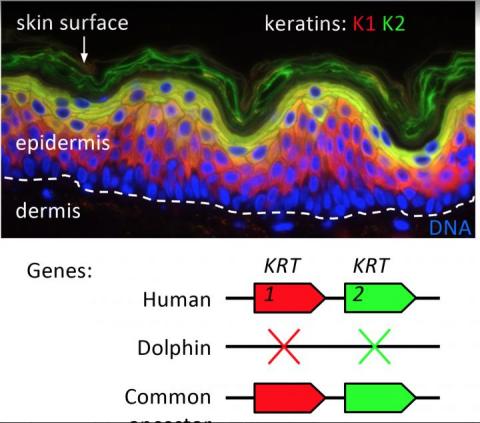The products of these keratin genes assemble to form the girders of the cytoskeleton in skin cells, called keratinocytes, that maintain a tight barrier between the body and the outside world.
In terrestrial mammals, the epidermis depends on different keratins to maintain the barrier to the environment and to regenerate the epidermis if the skin is wounded. The new report proposes that fully aquatic mammals continuously use the epidermal regeneration program and therefore require only one of the two sets of epidermal keratins.

Credit: Leopold Eckhart
The main proteins of the outermost skin layers of terrestrial mammals, including humans, are dispensable in aquatic mammals, such as dolphins, whales, and manatees and a stress response program was the starting point of an evolutionary innovation: the new architecture of the epidermis in aquatic mammals. The epidermis of dolphins is approximately 50 times thicker than normal human epidermis. Keratins K1, K2, and K10 have been lost and replaced by keratins K6 and K17 in dolphins.
Both the thickening of the epidermis and the key roles of K6 and K17 are also found in human skin wound healing and in lesional skin of patients with psoriasis. In this common skin disease, so-far-unknown genetic factors predispose skin cells to trigger the evolutionarily ancient wound healing program of the epidermis. The research team also discovered previously underestimated complexity in the epidermal keratin composition due to so-called "alternative splicing" keratin K10 mRNA and adaptations of keratin gene sets in terrestrial mammals. However, an entire remodeling of the keratin cytoskeleton has occurred only in fully aquatic mammals.
"At this point evolutionary biology meets dermatological research, and we hope that this type of 'translational research' will yield further insights for the benefit of patients in the future," says Leopold Eckhart from the Department of Dermatology, Medical University of Vienna.






Comments